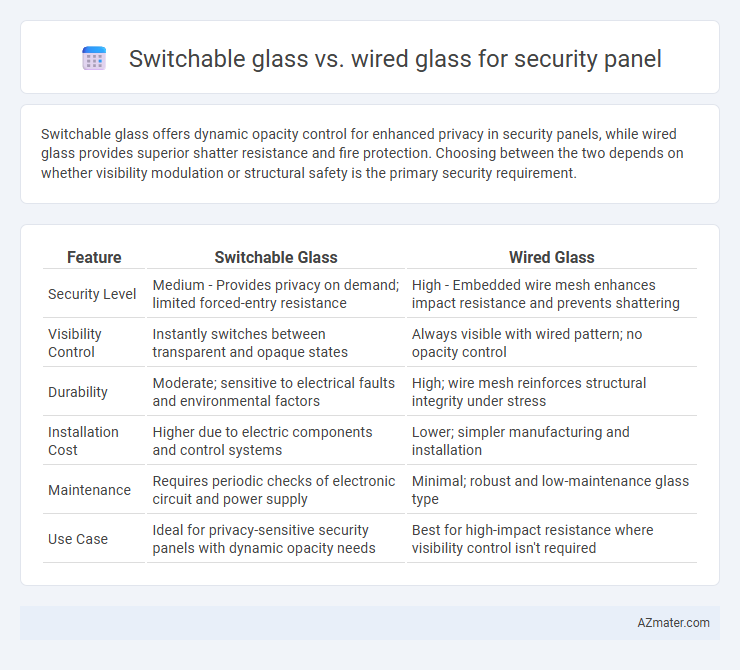Switchable glass offers dynamic opacity control for enhanced privacy in security panels, while wired glass provides superior shatter resistance and fire protection. Choosing between the two depends on whether visibility modulation or structural safety is the primary security requirement.
Table of Comparison
| Feature | Switchable Glass | Wired Glass |
|---|---|---|
| Security Level | Medium - Provides privacy on demand; limited forced-entry resistance | High - Embedded wire mesh enhances impact resistance and prevents shattering |
| Visibility Control | Instantly switches between transparent and opaque states | Always visible with wired pattern; no opacity control |
| Durability | Moderate; sensitive to electrical faults and environmental factors | High; wire mesh reinforces structural integrity under stress |
| Installation Cost | Higher due to electric components and control systems | Lower; simpler manufacturing and installation |
| Maintenance | Requires periodic checks of electronic circuit and power supply | Minimal; robust and low-maintenance glass type |
| Use Case | Ideal for privacy-sensitive security panels with dynamic opacity needs | Best for high-impact resistance where visibility control isn't required |
Introduction to Security Glass Solutions
Switchable glass and wired glass offer distinct security features for security panel solutions. Switchable glass provides privacy and security by electronically controlling transparency, enhancing visual protection without compromising aesthetics. Wired glass incorporates embedded metal wire mesh, offering superior fire resistance and impact strength, making it ideal for high-security environments requiring enhanced durability and safety compliance.
What is Switchable Glass?
Switchable glass, also known as smart glass, uses an electrochromic or polymer-dispersed liquid crystal layer to alter transparency with an electric current, providing instant privacy and security control. Unlike wired glass, which contains embedded wire mesh for fire resistance but limited visibility control, switchable glass offers dynamic opacity adjustments enhancing security panels by controlling sightlines and access visually. This technology is essential for security applications requiring flexible privacy without compromising natural light or aesthetic design.
What is Wired Glass?
Wired glass is a type of safety glass embedded with a grid of thin metal wire mesh designed to hold the glass together if shattered, enhancing its fire-resistant properties. Commonly used in security panels and fire-rated doors, wired glass provides a strong barrier that resists breakage while allowing visibility. Unlike switchable glass, which uses electrochromic technology to control transparency, wired glass maintains a consistent clear appearance focused on durability and fire safety.
Switchable Glass: Security Features
Switchable glass enhances security panels with its ability to instantly transition from transparent to opaque, preventing unauthorized visual access and protecting sensitive information. Unlike wired glass, which offers structural durability but limited privacy control, switchable glass integrates smart technology to ensure real-time privacy customization. This advanced security feature makes switchable glass ideal for high-security environments requiring both visibility control and physical protection.
Wired Glass: Security Strengths and Weaknesses
Wired glass offers enhanced fire resistance and impact strength due to its embedded metal mesh, providing robust physical security for panels. Its network of wires helps prevent glass shattering upon impact, reducing injury risk and delaying forced entry. However, wired glass is prone to limited visibility and potential wire corrosion over time, which can undermine its aesthetic appeal and long-term durability compared to switchable glass technology.
Impact Resistance: Comparing Switchable and Wired Glass
Switchable glass offers moderate impact resistance through its laminated structure, designed to maintain integrity upon impact, whereas wired glass provides higher impact resistance due to its embedded steel wire mesh. Wired glass is traditionally favored for security panels requiring enhanced shatter resistance and fire safety, as the wire mesh helps hold the glass together under force. However, switchable glass balances impact resistance with advanced privacy control, making it suitable for environments where both security and dynamic opacity are critical.
Visibility and Privacy: Which Option Performs Better?
Switchable glass offers superior control over visibility by instantly transitioning from transparent to opaque, providing dynamic privacy tailored to security needs without sacrificing natural light. Wired glass, while robust and fire-resistant, remains permanently translucent and cannot adjust its visibility, limiting privacy options. For security panels demanding flexible privacy and clear visibility management, switchable glass outperforms wired glass in functionality and user experience.
Fire Safety and Compliance Considerations
Switchable glass offers advanced fire safety benefits by maintaining visibility while providing up to 60 minutes of fire resistance, meeting strict building codes such as ASTM E119. Wired glass, traditionally used for fire-rated panels, provides strong fire protection but compromises visibility and modern security requirements due to its brittle nature and susceptibility to shattering under impact. For compliance, switchable glass aligns with contemporary fire safety regulations and security standards, ensuring effective containment of fire and smoke without sacrificing occupant safety or functionality.
Cost Analysis: Switchable Glass vs Wired Glass
Switchable glass offers higher upfront costs compared to wired glass, primarily due to advanced electrochromic technology and installation complexity. Wired glass tends to be more cost-effective, with lower material and maintenance expenses, making it suitable for budget-sensitive security panel applications. Long-term expenses for switchable glass may include energy savings and enhanced privacy, offsetting initial investments over time.
Choosing the Best Glass for Security Panels
Switchable glass offers advanced privacy and secure viewing control for security panels, allowing users to toggle transparency while maintaining impact resistance. Wired glass provides enhanced fire resistance and shatter protection, making it suitable for high-risk security applications requiring durability under extreme conditions. Selecting the best glass depends on balancing privacy needs, security standards, impact resistance, and fire safety compliance specific to the installation environment.

Infographic: Switchable glass vs Wired glass for Security panel
 azmater.com
azmater.com